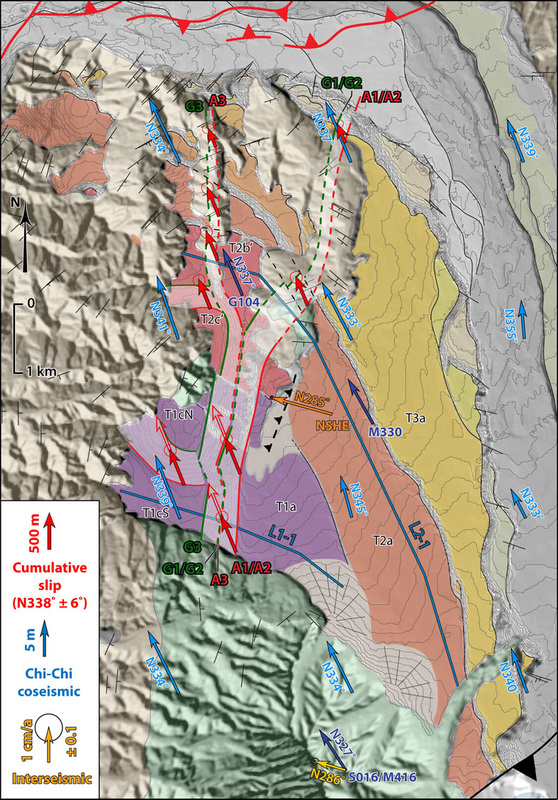Active fault-related folds > Deciphering cumulative fault slip vector on the Northern Chelungpu fault
|
- Objectives: Quantify long-term fault slip rate, assess temporal evolution of slip rate on an active thrust of a mountain piedmont, assess seismic hazard in Western Taiwan
- Approach: Morpho-tectonic analysis of a series of deformed river terraces, dating of the terrace levels, and integration of structural sub-surface data and geodetic data - Results and implications: Three main terrace levels show progressive folding by kink-band migration in relation to the underlying fault geometry, forming a main N-S fold scarp up to ~193 m high and secondary E-W scarps. Detailed analysis using 5-m resolution DEM allows us to characterize the scarp morphology and quantify the deformation parameters, namely terrace heights, fold scarp relief, and fold limb width and slope angle. 3D deformation of the highest terrace, OSL-dated at 30.2 ± 4.0 ka, enables to simultaneously determine amplitude and azimuth of the long-term slip vector based on scarp relief. The long-term slip vector, oriented N338˚ ± 6˚, is found to parallel the Chi-Chi coseismic displacements in this area (see Figure). Cumulative slip and dating results yield a constant slip rate of 17.7 ± 2.2 mm/a in the direction N338˚ ± 6˚. Late Quaternary shortening rates observed at four sites on the Chelungpu fault vary along-strike in a similar way to Chi-Chi coseismic displacements. Together with the collinearity of long-term and coseismic slip vectors at our study site, this suggests that Chi-Chi earthquake is a characteristic earthquake for the Chelungpu thrust with a recurrence interval of ~440 years. We also discuss implications for the regional and long-term distribution of shortening in the central Western Foothills. >> Read more: Le Béon M., J. Suppe, M. K. Jaiswal, Y-G. Chen, M. E. Ustaszewski, Deciphering cumulative fault slip vectors from fold scarps: relationships between long-term and coseismic deformation in central Western Taiwan, J. Geophys. Res., 119, doi:10.1002/2013JB010794 Selected for online publication in AGU EOS Research Spotlights !! [Rosen, 2015] |
Morpho-tectonic map of the study site
We highlight here the orientation of the long-term slip vector (red), which was found to parallel 1999 Chi-Chi coseismic slip vectors (blue).
|

